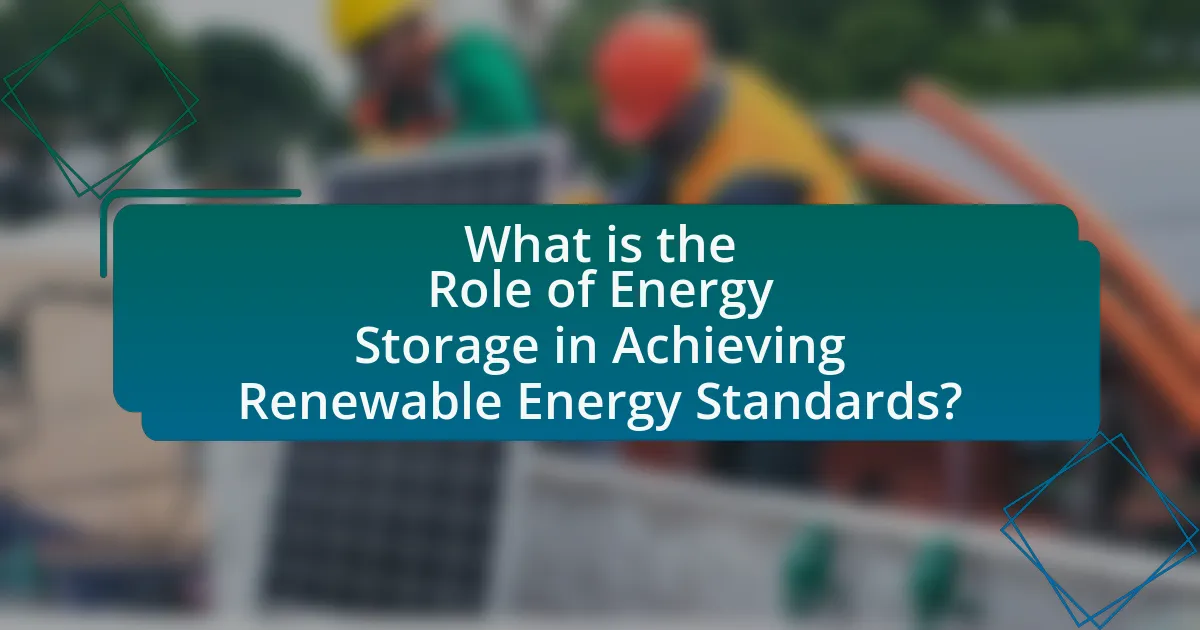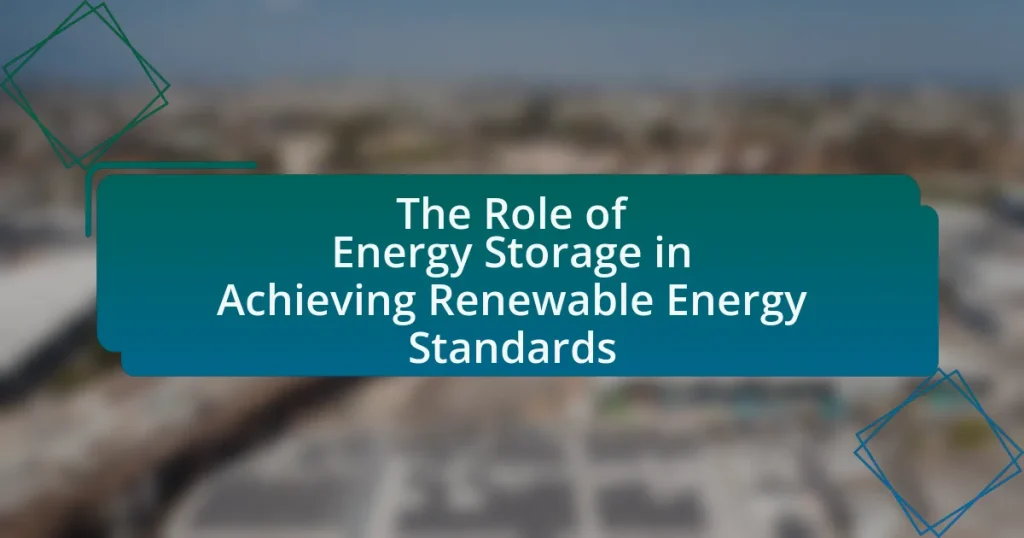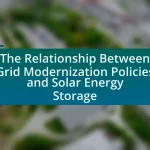Energy storage is a critical component in achieving renewable energy standards, facilitating the integration of intermittent sources such as solar and wind into the energy grid. This article examines the role of energy storage systems, including batteries and pumped hydro storage, in balancing supply and demand, enhancing grid stability, and reducing reliance on fossil fuels. It also discusses the various technologies available, their environmental impacts, economic benefits, and the regulatory frameworks that support their development. Additionally, the article highlights future trends and best practices for implementing energy storage solutions, emphasizing their importance in optimizing energy consumption and meeting global renewable energy targets.
What is the Role of Energy Storage in Achieving Renewable Energy Standards?


Energy storage plays a crucial role in achieving renewable energy standards by enabling the integration of intermittent renewable sources like solar and wind into the energy grid. Energy storage systems, such as batteries, allow for the capture and retention of excess energy generated during peak production times, which can then be released during periods of high demand or low generation. This capability enhances grid stability, reduces reliance on fossil fuels, and facilitates the transition to a cleaner energy system. According to the International Renewable Energy Agency, energy storage can increase the share of renewables in the energy mix, making it essential for meeting global renewable energy targets.
How does energy storage contribute to renewable energy integration?
Energy storage significantly enhances renewable energy integration by providing a mechanism to balance supply and demand. It allows excess energy generated during peak production times, such as sunny or windy periods, to be stored and released when production is low or demand is high. For instance, according to the U.S. Department of Energy, energy storage systems can improve grid reliability and resilience, facilitating the incorporation of higher percentages of renewable energy sources into the energy mix. This capability is crucial for managing the intermittent nature of renewables, ensuring a stable and continuous energy supply.
What types of energy storage technologies are most effective?
The most effective types of energy storage technologies include lithium-ion batteries, pumped hydro storage, and compressed air energy storage. Lithium-ion batteries are widely used due to their high energy density and efficiency, achieving round-trip efficiencies of around 90-95%. Pumped hydro storage, which accounts for approximately 95% of global energy storage capacity, utilizes gravitational potential energy to store and release energy, demonstrating efficiencies of about 70-90%. Compressed air energy storage, while less common, can provide large-scale storage solutions with efficiencies ranging from 60-80%. These technologies are critical in balancing supply and demand in renewable energy systems, facilitating the integration of intermittent energy sources like solar and wind.
How do these technologies support renewable energy sources?
Energy storage technologies support renewable energy sources by enabling the efficient capture and utilization of energy generated from intermittent sources like solar and wind. These technologies, such as batteries and pumped hydro storage, allow for the storage of excess energy produced during peak generation times, which can then be released during periods of low generation or high demand. For instance, according to the International Renewable Energy Agency, energy storage can increase the reliability and flexibility of renewable energy systems, facilitating a higher penetration of renewables into the energy mix. This capability is crucial for balancing supply and demand, thus enhancing the overall stability and efficiency of renewable energy systems.
Why is energy storage critical for grid stability?
Energy storage is critical for grid stability because it balances supply and demand, ensuring a reliable electricity flow. When renewable energy sources, such as solar and wind, produce excess energy, storage systems can capture and store this energy for later use, preventing grid overload. Conversely, during periods of high demand or low generation, stored energy can be released to maintain stability. According to the U.S. Department of Energy, energy storage can enhance grid resilience by providing backup power during outages and facilitating the integration of variable renewable energy sources, which accounted for 20% of U.S. electricity generation in 2020. This capability is essential for maintaining a stable and efficient grid as the share of renewables continues to grow.
What challenges does intermittent renewable energy pose to the grid?
Intermittent renewable energy poses significant challenges to the grid, primarily due to its variable and unpredictable nature. This variability can lead to mismatches between energy supply and demand, resulting in potential grid instability. For instance, solar and wind energy generation can fluctuate based on weather conditions, causing difficulties in maintaining a consistent power supply. According to the National Renewable Energy Laboratory, integrating high levels of intermittent renewables can require additional grid management strategies, such as demand response and energy storage solutions, to ensure reliability and balance.
How does energy storage mitigate these challenges?
Energy storage mitigates challenges in renewable energy integration by providing a buffer that balances supply and demand fluctuations. This technology allows excess energy generated during peak production times, such as sunny or windy days, to be stored and released during periods of low generation or high demand. For instance, according to the U.S. Department of Energy, energy storage systems can enhance grid reliability and stability, enabling a higher penetration of renewable sources like solar and wind, which are inherently variable. By smoothing out these fluctuations, energy storage helps to ensure a consistent energy supply, thereby addressing issues related to intermittency and enhancing the overall efficiency of renewable energy systems.
What are the environmental impacts of energy storage systems?
Energy storage systems have significant environmental impacts, both positive and negative. On the positive side, they facilitate the integration of renewable energy sources, such as solar and wind, by storing excess energy for later use, which helps reduce reliance on fossil fuels and lowers greenhouse gas emissions. For instance, a study by the National Renewable Energy Laboratory found that energy storage can reduce carbon emissions by up to 30% in certain grid scenarios.
Conversely, the production and disposal of energy storage systems, particularly batteries, can lead to environmental concerns. The extraction of raw materials, such as lithium and cobalt, often involves environmentally damaging mining practices. Additionally, improper disposal of batteries can result in soil and water contamination due to toxic substances. Research published in the journal Nature Sustainability highlights that the lifecycle emissions of lithium-ion batteries can be substantial, depending on the energy sources used in their production.
Overall, while energy storage systems play a crucial role in enhancing renewable energy adoption and reducing emissions, their environmental impacts must be carefully managed to mitigate negative effects associated with material sourcing and waste management.
How do energy storage systems compare to traditional energy sources?
Energy storage systems provide a flexible and efficient alternative to traditional energy sources by enabling the capture and release of energy as needed, which enhances grid reliability and supports renewable energy integration. Unlike traditional energy sources, such as fossil fuels, which generate power continuously and can lead to emissions, energy storage systems can store excess energy generated during low demand periods and release it during peak demand, thus optimizing energy use and reducing waste. For instance, according to the U.S. Department of Energy, energy storage can help integrate up to 30% of renewable energy sources into the grid without compromising reliability, demonstrating its critical role in modern energy systems.
What are the lifecycle impacts of different energy storage technologies?
The lifecycle impacts of different energy storage technologies vary significantly based on their materials, manufacturing processes, operational efficiency, and end-of-life management. For instance, lithium-ion batteries, widely used in electric vehicles and grid storage, have a high energy density but involve resource-intensive mining of lithium, cobalt, and nickel, leading to environmental degradation and social issues in mining regions. In contrast, pumped hydro storage, which relies on gravitational potential energy, has a lower carbon footprint during operation but can disrupt local ecosystems and water resources during construction. Additionally, flow batteries, which utilize liquid electrolytes, offer longer lifespans and recyclability but may require toxic materials that pose disposal challenges. Research indicates that the total greenhouse gas emissions from lithium-ion batteries can be around 150-200 kg CO2 equivalent per kWh produced, while pumped hydro can have emissions as low as 5 kg CO2 equivalent per kWh, depending on the site and construction methods. Therefore, the lifecycle impacts of energy storage technologies must be carefully assessed to balance their benefits in renewable energy integration with their environmental and social costs.
How does energy storage enhance energy efficiency?
Energy storage enhances energy efficiency by allowing for the capture and utilization of excess energy generated during peak production times, which can then be used during periods of high demand. This capability reduces the need for additional energy generation, particularly from fossil fuels, thereby minimizing energy waste and optimizing resource use. For instance, according to the U.S. Department of Energy, energy storage systems can improve grid reliability and reduce energy costs by balancing supply and demand, which leads to a more efficient energy system overall.
What role does energy storage play in demand response strategies?
Energy storage plays a crucial role in demand response strategies by enabling the balancing of supply and demand in real-time. It allows for the storage of excess energy generated during low-demand periods, which can then be released during peak demand times, thus reducing strain on the grid. For instance, according to the U.S. Department of Energy, energy storage systems can enhance grid reliability and efficiency, facilitating the integration of renewable energy sources like solar and wind. This capability not only helps in managing energy loads but also supports the overall stability of the energy system, making demand response initiatives more effective.
How can energy storage optimize energy consumption patterns?
Energy storage optimizes energy consumption patterns by enabling the efficient management of energy supply and demand. By storing excess energy generated during low-demand periods, such as from renewable sources like solar and wind, energy storage systems can release this energy during peak demand times, reducing strain on the grid and lowering energy costs. For instance, according to the U.S. Department of Energy, energy storage can help integrate up to 30% of renewable energy into the grid without compromising reliability. This capability not only enhances grid stability but also promotes the use of cleaner energy sources, aligning with renewable energy standards.
What are the economic benefits of energy storage in renewable energy systems?
Energy storage in renewable energy systems provides significant economic benefits by enhancing grid reliability and reducing energy costs. By storing excess energy generated during peak production times, such as sunny or windy periods, energy storage systems enable a more stable supply of electricity, which can lower the need for expensive peaking power plants. According to a report by the International Renewable Energy Agency, energy storage can reduce electricity costs by up to 30% by optimizing the use of renewable resources and minimizing reliance on fossil fuels. Additionally, energy storage systems can provide ancillary services, such as frequency regulation and demand response, which further contribute to economic savings and efficiency in the energy market.
How does energy storage reduce costs for consumers and utilities?
Energy storage reduces costs for consumers and utilities by enabling the efficient management of energy supply and demand. By storing excess energy generated during low-demand periods, utilities can release this energy during peak demand times, thus avoiding the need for expensive peaking power plants. According to the U.S. Department of Energy, energy storage can lower electricity costs by up to 30% by reducing the need for costly infrastructure and improving grid reliability. Additionally, consumers benefit from lower electricity bills as energy storage systems allow them to utilize stored energy during high-rate periods, further decreasing overall energy expenses.
What financial incentives exist for implementing energy storage solutions?
Financial incentives for implementing energy storage solutions include federal tax credits, state-level rebates, and performance-based incentives. The federal Investment Tax Credit (ITC) allows for a tax credit of up to 30% of the installation cost for energy storage systems paired with solar energy. Additionally, many states offer rebates that can significantly reduce upfront costs, such as California’s Self-Generation Incentive Program, which provides financial support for energy storage projects. Performance-based incentives, like those in New York’s Value of Distributed Energy Resources program, reward energy storage systems based on their contribution to the grid, further enhancing the financial viability of these solutions.
How can policy frameworks support energy storage development?
Policy frameworks can support energy storage development by providing regulatory incentives, funding opportunities, and clear guidelines that encourage investment in storage technologies. For instance, policies such as tax credits, grants, and subsidies can lower the financial barriers for companies developing energy storage solutions. Additionally, establishing standards and interconnection rules can streamline the integration of energy storage into existing energy systems, facilitating its adoption. Evidence of this can be seen in California’s Self-Generation Incentive Program, which has successfully increased energy storage capacity by offering financial incentives, resulting in a significant rise in installed storage systems.
What regulations are currently in place for energy storage systems?
Currently, regulations for energy storage systems vary by region but generally include safety standards, interconnection requirements, and market participation rules. In the United States, the National Fire Protection Association (NFPA) has established codes such as NFPA 855, which outlines safety requirements for energy storage systems. Additionally, the Federal Energy Regulatory Commission (FERC) has implemented Order 841, which mandates that regional transmission organizations and independent system operators allow energy storage resources to participate in wholesale electricity markets. These regulations aim to ensure the safe integration of energy storage into the grid while promoting competition and efficiency in energy markets.
How can governments promote energy storage adoption?
Governments can promote energy storage adoption by implementing financial incentives, regulatory frameworks, and public awareness campaigns. Financial incentives, such as tax credits or grants, lower the initial investment barrier for consumers and businesses, encouraging them to adopt energy storage technologies. Regulatory frameworks that prioritize energy storage in energy planning and grid management can facilitate integration into existing systems, as seen in California’s energy storage mandate, which aims for 1,325 megawatts of storage by 2024. Public awareness campaigns can educate stakeholders about the benefits of energy storage, including enhanced grid reliability and reduced energy costs, thereby driving demand and acceptance.
What are the future trends in energy storage technology?
Future trends in energy storage technology include advancements in solid-state batteries, increased adoption of lithium-sulfur batteries, and the development of flow batteries. Solid-state batteries are expected to enhance energy density and safety, as they replace liquid electrolytes with solid materials, potentially leading to longer-lasting and more efficient energy storage solutions. Lithium-sulfur batteries are gaining attention due to their higher theoretical energy capacity compared to traditional lithium-ion batteries, which could significantly reduce costs and improve performance for electric vehicles and grid storage. Flow batteries, particularly vanadium redox flow batteries, are being explored for their scalability and long-duration energy storage capabilities, making them suitable for balancing intermittent renewable energy sources like solar and wind. These trends are supported by ongoing research and investment in energy storage technologies, which aim to address the growing demand for efficient and sustainable energy solutions.
How is innovation shaping the energy storage landscape?
Innovation is significantly transforming the energy storage landscape by enhancing efficiency, reducing costs, and increasing the scalability of storage solutions. Advanced technologies such as lithium-sulfur batteries and solid-state batteries are emerging, offering higher energy densities and longer lifespans compared to traditional lithium-ion batteries. For instance, a study by the National Renewable Energy Laboratory indicates that solid-state batteries can potentially increase energy density by 50% while improving safety. Additionally, innovations in flow battery technology are enabling longer-duration energy storage, which is crucial for balancing intermittent renewable energy sources like solar and wind. These advancements are essential for meeting renewable energy standards and facilitating the transition to a sustainable energy future.
What emerging technologies show promise for enhancing energy storage?
Emerging technologies that show promise for enhancing energy storage include solid-state batteries, flow batteries, and advanced supercapacitors. Solid-state batteries utilize solid electrolytes, which can improve energy density and safety compared to traditional lithium-ion batteries. Flow batteries, such as vanadium redox flow batteries, offer scalability and long-duration energy storage, making them suitable for grid applications. Advanced supercapacitors provide rapid charge and discharge capabilities, which are beneficial for applications requiring quick bursts of energy. These technologies are being actively researched and developed to address the limitations of current energy storage systems, thereby supporting the integration of renewable energy sources into the grid.
What best practices should be followed when implementing energy storage systems?
When implementing energy storage systems, best practices include conducting a thorough site assessment, selecting appropriate technology, ensuring regulatory compliance, and integrating with existing energy systems. A comprehensive site assessment identifies optimal locations and conditions for energy storage, which can enhance efficiency and performance. Choosing the right technology, such as lithium-ion or flow batteries, is crucial for meeting specific energy needs and operational requirements. Compliance with local regulations ensures safety and legal adherence, while integration with existing energy systems maximizes the benefits of energy storage, facilitating smoother energy transitions and enhancing grid stability. These practices are supported by industry standards and guidelines, such as those from the International Electrotechnical Commission (IEC) and the National Renewable Energy Laboratory (NREL), which provide frameworks for effective energy storage implementation.


